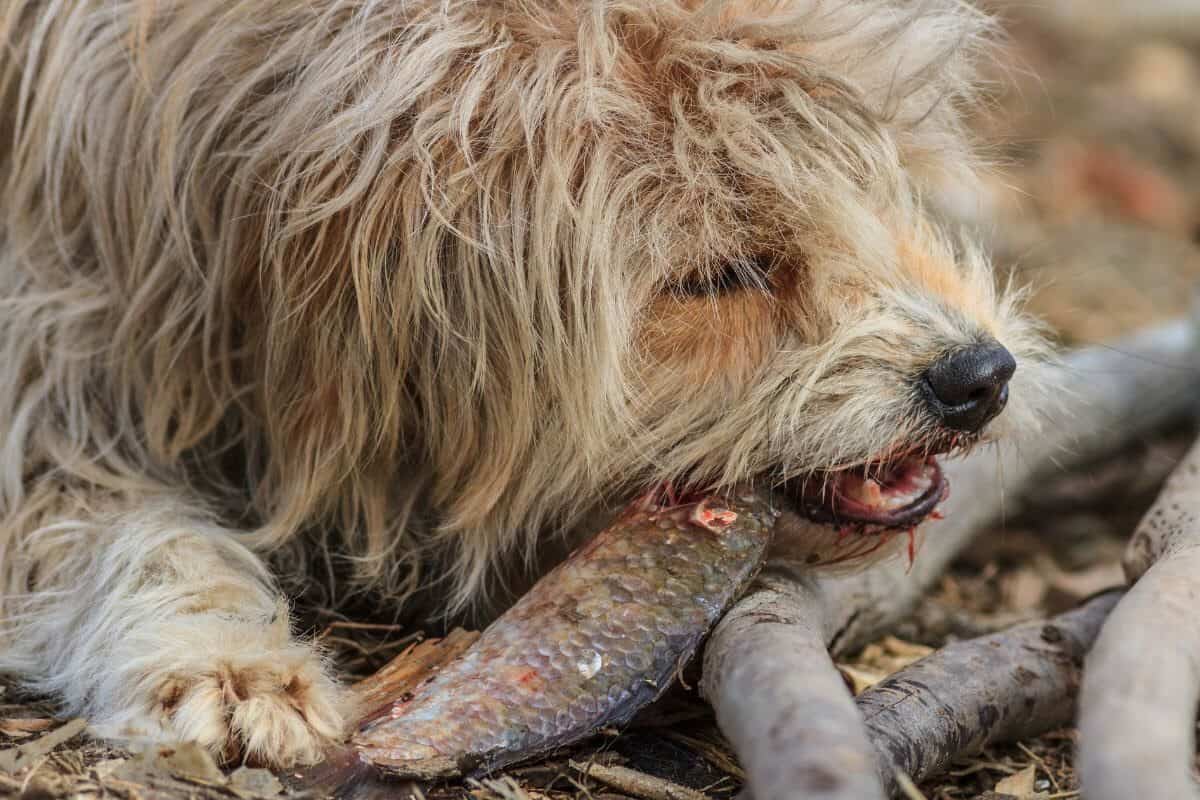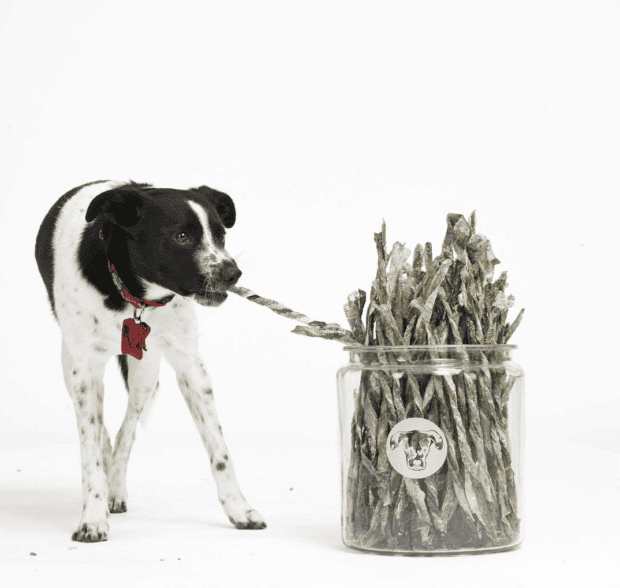If you cook fish frequently, there's a good chance that your pup will give you a look like, "What about me?" That's when the question pops up: Can dogs eat fish? Get ready to learn all about the nutrition, risks, and sheer joy of sharing our love for fish with our furry buddies!

***Please note, I am not a veterinarian, just a very passionate dog owner! The information in this blog post documents our own personal experiences, research, and the recipes that we feed our dogs under our veterinarian's careful supervision. Please, consult with your vet and use your own personal judgment when considering transitioning to a 100% human-grade food diet for your pup.***
This post contains affiliate links. If you make a purchase, we may receive a small commission. Thank you for supporting our small business!
Fish for Dogs: Unleashing the Health Benefits!
For starters, YES! Dogs can eat fish! Certain types of fish are really good for them! Think shiny coats, happy joints, and an overall vitality boost, all thanks to those omega-3 fatty acids and protein-packed goodness. When you're pondering, "Can dogs eat fish?" just remember, it's like giving your pup a ticket to health and happiness with every bite!

Fish, especially fatty varieties like salmon and mackerel, are packed with omega-3 fatty acids. These essential fats work wonders for your pup's overall well-being. They promote a glossy, luscious coat, reducing itchiness and dryness. Plus, omega-3s support cognitive function, keeping those doggy brains sharp and ready for playtime!
Whether aging or active, every dog can benefit from the joint-loving properties of fish. Omega-3s, in particular, contribute to reducing inflammation and promoting joint flexibility. This is especially crucial for breeds prone to joint issues, giving them a fantastic boost in mobility.

Just like in humans, a heart-healthy diet matters for our canine companions. Fish contains heart-friendly nutrients like EPA and DHA, which support cardiovascular health. By including fish in your dog's meals, you're giving their ticker some extra love and care.
Navigating Safe Fish Options
Now, not all fish are created equal in the doggy world. We're talking low-mercury superstars like salmon and whitefish, cooked to perfection and bone-free. Saying "yes" to fish for your pup is like curating a gourmet experience; it's all about making choices that are safe and downright tasty.
Dog-Safe Fish Options:

Salmon:
- Benefits: Rich in omega-3 fatty acids, salmon supports a glossy coat, reduces inflammation, and aids cognitive function. It's a top-tier choice for overall canine well-being.
- Preparation: Ensure it's cooked thoroughly, boneless, and free from any added seasonings or spices.

Whitefish (Cod, Haddock, Catfish):
- Benefits: Low in fat and a good source of lean protein, whitefish contributes to muscle development and weight management. It's gentle on the stomach, making it suitable for dogs with sensitive tummies.
- Preparation: Cook it well, removing bones and avoiding excessive seasoning.

Tuna:
- Benefits: A lean protein source, tuna provides essential amino acids for muscle health. It also contains omega-3s, promoting a shiny coat and supporting cardiovascular function.
- Preparation: Opt for canned tuna in water, and ensure it's free from added salts or oils. Moderation is key due to potential mercury content.

Trout:
- Benefits: Packed with protein and omega-3s, trout contribute to healthy skin, coat, and joints. It's a flavorful option that adds variety to your dog's diet.
- Preparation: Cook it thoroughly, removing bones and checking for any signs of contamination.

Sardines:
- Benefits: A nutrient powerhouse, sardines are loaded with omega-3s, calcium, and vitamin D. They support bone health, aid in inflammation reduction, and contribute to overall vitality.
- Preparation: Opt for canned sardines in water, and make sure they're boneless.

Mackerel:
- Benefits: Mackerel is a nutrient-dense fish, loaded with omega-3s, vitamin D, and B vitamins. It supports heart health, boosts the immune system, and contributes to a shiny coat.
- Preparation: Grilled or baked mackerel is a hit. Remove the bones and keep it plain – your pup will thank you for this flavorful and healthy treat.
Navigating Risks and Precautions for Pooches:
While fish can be a delicious and nutritious addition to your dog's diet, not all aquatic delights are pup-friendly. Let's talk about the fish varieties that can pose risks to your furry friend:
- Raw Fish:
- Risks: Raw fish, like sushi or sashimi, may contain harmful bacteria, parasites, or pathogens that can lead to foodborne illnesses in dogs. It's best to avoid serving raw fish to your canine companion.
- High-Mercury Fish:
- Risks: Certain fish, such as shark, swordfish, and king mackerel, are high in mercury, which can negatively impact a dog's nervous system. Excessive mercury intake may lead to mercury poisoning. Stick to low-mercury options like salmon and whitefish.
- Fish with Small Bones:
- Risks: Small, fine bones in certain fish varieties, like trout or herring, can pose a choking hazard or cause digestive issues for dogs. Always debone fish thoroughly before serving it to your pup.
- Flavored or Seasoned Fish:
- Risks: Avoid fish that's seasoned, flavored, or prepared with additives like garlic and onions. These ingredients can be toxic to dogs and may lead to gastrointestinal distress or more severe health issues.
- Farmed Salmon with Additives:
- Risks: Some farmed salmon may contain additives, antibiotics, or artificial colors that are not ideal for canine consumption. Opt for wild-caught or responsibly sourced salmon without additives.

Smoothly Introducing Fish to Your Pup's Diet
Like any new food, start small. Introduce fish to your dog's diet in small portions to allow their digestive system to adjust. Begin with mild-flavored fish like whitefish or cod. These varieties are less intense for your dog's palate, making the introduction more enjoyable. Ensure the fish is fully cooked to eliminate any potential bacteria or parasites. Stick to simple cooking methods like baking or grilling without added seasonings. Always debone the fish thoroughly before serving. This prevents any choking hazards or digestive issues associated with small bones.
Keep an eye on your pup after introducing fish. Watch for any signs of allergies or digestive discomfort. If all goes well, you can gradually increase the fish portions over time. Mix the fish into your dog's regular meals or use it as a tasty topper. This helps them associate the new flavor with familiar favorites.

Our Favorite Fish Treat For Our Pups!

Crunchy Cod Skins
These Crunchy Cod Skins are the ultimate treat that your furry friend will love!
Packed with deliciousness and health benefits, these sticks are a great snack and a fantastic source of natural Omega-3 fatty acids for your pup's shiny coat and overall well-being!
Photo Source: Amazon

Native Pet Omega Oil
This Omega Oil offers multiple sources of Omega 3’s to give your dog all the best benefits. In addition to wild-caught salmon and pollock, they also added plant-based Wheat Germ Oil to complete the fatty acid profile.
Photo Source: Native Pet





Leave a Reply